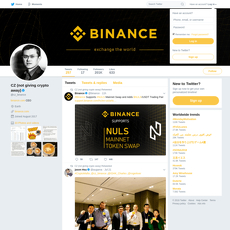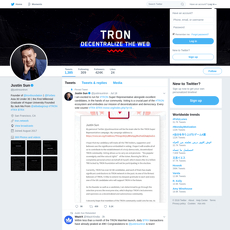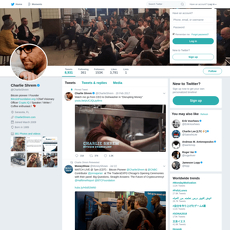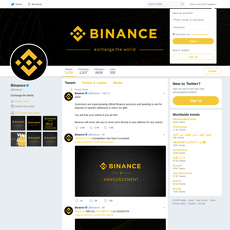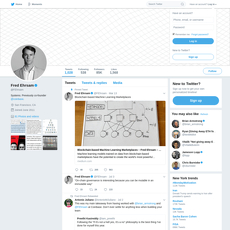Jeff Garzik Review
Jeff Garzik
twitter.com
Jeff Garzik Review Guide: Everything You Need to Know + FAQ
Is following Jeff Garzik (@jgarzik) on X/Twitter actually worth your attention—and what can you learn from him without getting lost in the noise?
I’ve spent years sorting signal from hype across crypto feeds, tools, and sites. This guide is built to save you time: what to watch for on his timeline, what not to expect, and how to turn his posts into practical insight for research or building.
Your timeline is only as good as the sources you choose.
Why this is harder than it looks
High‑profile crypto accounts can be a mixed bag. Smart threads land next to hot takes, and outdated claims often resurface with fresh likes. Add the fact that false or low‑quality information can spread fast—one well‑known study in Science (MIT, 2018) found that false news traveled farther and faster on Twitter than true news—and you’ve got a recipe for confusion.
So when you follow someone like Jeff Garzik, you need a plan. Not every post is a roadmap, not every debate is new, and not every thread is actionable for builders or investors. The goal here is to help you read his feed with context, so you can spot the good stuff quickly.
What you’ll get from this guide
I keep this focused and useful—no fluff, no tribalism. Expect:
- A practical read on his background and track record so you know why his voice shows up in key conversations.
- What he actually posts on X/Twitter, and how to interpret it in today’s market and development landscape.
- Clear pointers on separating signal from noise—with simple checks you can run in under a minute.
- A fast FAQ that answers the questions people actually ask about Jeff and his work.
Why this approach works: most people now scan social platforms for news, not just entertainment. In 2023, Pew Research found that many users routinely get news on social media. A simple system for vetting posts gives you an edge when speed and accuracy both matter.
Who this is for
- Builders who care about protocol choices, infrastructure trade‑offs, and long‑term roadmaps.
- Investors who want context behind narratives—beyond price talk.
- Researchers and analysts who need primary sources, code links, and historical perspective.
- Crypto‑curious readers who want a straight take on whether following @jgarzik makes sense.
How I evaluate crypto profiles on X/Twitter
- Track record: Has this person contributed meaningfully to open‑source, standards, or shipped products?
Quick check: look for references to GitHub commits, BIPs/EIPs, or long‑form talks where they explain decisions. - Contribution quality: Are posts grounded in code, data, or primary sources?
Quick check: links to repos, specs, or official announcements score higher than screenshots of screenshots. - Consistency: Do they stick to an area of expertise and update views as facts change?
Quick check: scan recent threads for follow‑ups, corrections, or progress notes rather than one‑off takes. - Transparency: Do they disclose affiliations or potential conflicts when discussing projects?
Quick check: watch for clear labels (e.g., “advisor,” “investor,” “core contributor”). - Usefulness for decision‑making: Can their posts help you ship, research, or set strategy—not just react?
Quick check: posts that link to implementation details, proposals, or measurable outcomes are keepers.
Real example of applying this system to any crypto feed: a thread that links to a BIP or a GitHub discussion is usually higher signal than a viral quote‑tweet with no source. A policy comment tied to an official hearing or draft is stronger than second‑hand summaries. You don’t need to read every reply—just filter for posts that move work forward.
Ready to get the context that makes his posts click? Up next, I’ll quickly walk through who Jeff Garzik is—early career, Bitcoin years, founder phase, and what he focuses on today—so you can read his timeline with the right lens. Want the 30‑second version or the full backstory?
Who is Jeff Garzik? A quick background
Early career (pre-crypto)
I first came across Jeff through the Linux world, not crypto. He wasn’t just “into open‑source” — he wrote and maintained serious production code. If you’ve ever plugged in a SATA drive on a Linux machine, there’s a decent chance you’ve touched work he helped shepherd (the ATA/SATA stack known as libata is a common example associated with his name among kernel folks).
That matters. It means he cut his teeth in environments where code gets reviewed by battle‑hardened engineers and shipped into mission‑critical systems. You can see years of commit history attached to his name in the upstream kernel logs:
- Linux kernel commits mentioning Jeff Garzik
“Talk is cheap. Show me the code.” — Linus Torvalds
Jeff’s background fits that ethos. Less hype, more repositories. That engineering DNA shows up later in how he talks about Bitcoin, scaling, and infrastructure.
Early Bitcoin years
Jeff stepped into Bitcoin early, contributing code and weighing in on technical proposals when the project was still settling basic norms. Two concrete examples that are still useful for context today:
- BIP 100 — “Dynamic Max Blocksize by Miner Vote.” Proposed a miner‑signaled approach to block size changes. Read BIP 100
- BIP 102 — A straightforward 2 MB block size increase proposal. Read BIP 102
Whether or not you agreed with those approaches, they show his style: make a concrete, testable change; publish it; invite the gauntlet of review. You can also find early code activity tied to his handle in Bitcoin Core’s repo:
- Bitcoin Core commits by jgarzik
He was active on the bitcoin-dev mailing list, too — where the tone is blunt, the bar is high, and every design trade‑off gets interrogated. That period shaped a lot of his long‑term thinking around performance, safety, and how decentralized projects make decisions under pressure.
Founder phase
After shipping code for other people’s platforms, Jeff turned to building his own. He co‑founded Bloq in 2016 to focus on blockchain infrastructure for businesses and builders. The work there has spanned core infrastructure, mining tools, and protocol‑level experiments. A few notable, publicly documented examples:
- Metronome (2017): Positioned as a portable, chain‑agnostic asset with a rules‑first monetary policy. It was an ambitious attempt to separate a token’s economic rules from any single chain’s politics. Coverage on CoinDesk
- Titan (mining infrastructure): Software and services aimed at professionalizing and optimizing mining operations. Visit titan.io
Not every experiment from the 2017–2019 era aged the same way — that’s normal in a frontier market — but the through‑line is clear: build pragmatic tools, ship code, pressure‑test ideas in public.
Today’s focus
These days, you’ll see Jeff commenting on the nuts and bolts of crypto: protocol design, scaling paths, client implementations, mining, and sometimes the policy edges that can shape how infrastructure gets deployed. The tone is still engineer‑first — fewer memes, more mechanics — and he often points to specs, repos, or concrete proposals.
If you care about where the real bottlenecks are (networking, validation, fee markets, developer ergonomics), that perspective is useful context for any market narrative you hear elsewhere.
Want the short version of what he actually posts — and how to read it without getting lost in side quests? I’m about to unpack patterns, cadence, and practical “use‑this, skip‑that” tips next. Which type of post do you think carries the most signal: code links, policy threads, or scaling takes?
What Jeff posts on X/Twitter—and how to read it
Content themes to expect
If you’re opening his feed for the first time, expect a builder’s lens. Less cheerleading, more nuts-and-bolts. Here’s what consistently shows up:
- Infrastructure and protocol mechanics: Thoughts on Bitcoin internals, node behavior, mempool policy vs consensus rules, and how systems actually run in production.
- Scaling and performance: Block propagation, fee markets, L2 trade‑offs, and practical throughput constraints. Not “infinite TPS” hype—engineering trade‑offs.
- Standards and specs: Links or references to proposals (think BIPs), PRs, and draft specs. These are high‑signal because they tie to real work.
- Industry and policy: Comments on regulation, open‑source sustainability, enterprise adoption, and the realities of shipping infra at scale.
- Occasional personal notes: Brief life or travel observations—human, but not the main course.
Real‑world example to watch for: when he shares a PR or spec link with a short commentary like “activation parameters still under discussion”—that’s your cue to save it, not trade on it. It’s a map of what’s changing under the hood.
“Strong opinions age fast; facts live in the code.”
Posting cadence and tone
The tone leans technical and pragmatic. Threads appear when something substantive is moving—code, standards, or an industry shift. You won’t get daily memes or “gm”s. You’ll get terse takes, thoughtful quote‑tweets, and the occasional candid line that makes you pause.
- Cadence: Not spammy. Expect bursts around meaningful updates or debates, and quieter stretches when there isn’t much to add.
- Voice: Engineering first, policy second, market chatter distant third. If you want trading calls, this isn’t it.
Signal versus noise
Here’s my quick filter so you don’t get lost:
- High signal: Posts that link to repos, specs, BIPs, or long‑tail infra conversations. Look for words like “PR,” “draft,” “activation,” “consensus,” “policy,” “review requested.”
- Medium signal: Industry commentary with examples or links to primary sources (official announcements, release notes, testnet results).
- Low signal for traders: Any market‑timed reaction, price talk, or headlines without technical links. Useful for context, not decisions.
There’s also a human factor: hot takes travel faster than nuance. A well‑known Science study found false news spreads “farther, faster, deeper, and more broadly” on Twitter than true news. That’s your reminder to verify before you act.
Source: Science (2018): The spread of true and false news online
How to vet posts fast
I use this 60‑second checklist so I don’t get burned by screenshots or second‑hand summaries:
- Find the primary source: Is there a link to a repo, BIP, PR, issue, release note, or official statement?
- Check status: Proposed vs merged vs abandoned. Words like “draft,” “RFC,” or “requesting review” mean it’s not final.
- Cross‑verify: Search for independent dev threads or maintainer comments. Two sources beat one opinion.
- Timestamp matters: Old context can resurface. Make sure you’re not reacting to a 2017 debate with 2025 assumptions.
- Policy items: Look for the actual regulator PDF or official blog. Media summaries miss nuances.
- Company claims: Confirm on the org’s site, docs, or GitHub. Marketing slides are not commits.
Bonus: Community Notes can help on broad claims, but deep protocol nuance rarely fits in that box—trust code and credible maintainers first.
Pro tips for using his feed
- Build a focused List: Create an “Infra/Builders” List that includes him, a few Bitcoin core contributors, and standards authors. Lists cut through the algorithm haze.
- Track only key threads: Turn on notifications for threads that include links to specs, PRs, or release notes. Mute likes/retweets if your phone becomes a slot machine.
- Bookmark with intent: Save posts that reference specific proposals (“BIP-XYZ,” “PR #1234,” “activation params”). Add a note like “watch for merge” or “needs review feedback.”
- Use advanced search:
from:jgarzik (BIP OR PR OR spec OR RFC OR ‘release notes’)surfaces higher‑signal nuggets fast. - Create a mini‑workflow: When he flags a technical change, log the link in your research doc, jot the expected impact (e.g., “fee estimation policy”), and set a check‑back date for the next review/merge window.
- Separate sentiment from substance: A sharp one‑liner can be entertaining, but the attached link often holds the real value.
Curious how this posting style connects to the big scaling debates and why his takes land the way they do? That’s where the history gets useful—want the context that makes today’s posts click?
Notable contributions and flashpoints (what matters today)
Bitcoin/Core involvement
Jeff Garzik was one of the early hands in the Bitcoin codebase and on the bitcoin-dev mailing list, where a lot of the hard conversations about performance, safety, and standards actually happen. If you want receipts, he proposed concrete scaling ideas like BIP-100 (dynamic block size via miner signaling) and BIP-102 (a conservative 2 MB hard fork). Whether you agreed with those or not, they framed how the community debated trade-offs for years.
What still matters today: he thinks like an engineer who’s seen Bitcoin’s failure modes up close—bandwidth limits, node resource constraints, and the costs of coordination. When he talks about “pragmatic” trade-offs on X/Twitter, he’s speaking from that long-running tug-of-war between performance and decentralization.
- Where to verify: Browse the historical bitcoin-dev mailing list and the BIPs repo for his proposals and discussions.
Scaling debates context
If you weren’t around during the New York Agreement (NYA) and SegWit2x (2017), here’s the short version. A group of companies and miners agreed to activate SegWit and then hard-fork to a 2 MB block size. Jeff maintained the reference implementation for that plan, known as btc1 (github.com/btc1/bitcoin).
What followed was one of crypto’s loudest governance clashes. The fork never shipped; the plan was called off due to lack of broad consensus. The lessons stuck: off-chain deals don’t replace on-chain/community legitimacy, and “economic majority” is messier than a miner signature sheet. If you’re reading Jeff’s current takes, it helps to remember he’s pressure-tested by that era—he knows how ugly coordination can get and why process matters.
- Neutral timelines and postmortems: Bitcoin Wiki: New York Agreement, BitMEX Research: SegWit2x and the Cancelled Fork
- Takeaway for 2025: Any “simple” scaling fix that ignores governance will fail in production. Expect Jeff to weigh trade-offs, not chase applause.
“There are no solutions; only trade-offs.” — Thomas Sowell
That line sums up why Jeff’s posts still land with engineers. He tends to ask, “What breaks?” before, “What pumps?”
Company building: Bloq and beyond
After the early Bitcoin years, Jeff co-founded Bloq, a company focused on multi-chain infrastructure and enterprise tooling. Think node access, API layers, and building blocks that let teams ship without re-inventing the plumbing. If you track B2B crypto, Bloq’s value prop mirrors what the industry actually pays for: reliability, compliance knobs, and integration with existing stacks.
- Why this matters for his feed: you’ll see an “infra-first” lens—less heat, more uptime, and a bias for components that survive real-world usage.
- Practical read: Watch how he frames new protocol features—does it lower operational risk? Does it reduce node load? That’s the Bloq DNA peeking through.
Tokens, products, and experiments
Jeff has also been involved in experiments that tested new token mechanics and DeFi primitives, especially during 2017–2019 and the early DeFi wave. Two examples worth knowing:
- Metronome (MET): launched with an emphasis on monetary policy and cross-chain portability. At the time, “move your asset across chains” wasn’t the default assumption. Link: metronome.io
- Vesper Finance (VSP): a yield platform aiming to package strategies for easier, more conservative usage. Link: vesper.finance
Case-by-case is the only sane way to judge these. Before you commit time or capital, I recommend a quick 10-minute health check:
- Repos and cadence: active commits or a museum piece? Check GitHub activity linked from the project’s official site.
- Audits: confirm there’s a recent audit and read the summary, not just the badge.
- On-chain reality: review token liquidity and usage with tools like Etherscan and DeFiLlama.
- Community control: who can push upgrades or change parameters? Is there a multisig, timelock, or a real governance process?
This is also why I follow Jeff’s commentary on product design—he’s been through the “great idea vs. chain-of-custody reality” gap.
Talks, interviews, and panels
If you want the “why” behind his positions, go long-form. Quick tweets rarely carry the full context.
- Technical context: the Scaling Bitcoin conference archives capture the constraints and trade-offs the ecosystem wrestled with—and still does.
- Primary sources: older threads on the bitcoin-dev mailing list show how proposals are argued, revised, and sometimes abandoned.
- Historical record: SegWit2x-era panel clips and interviews offer context for his governance views; search “Jeff Garzik SegWit2x interview” on YouTube for direct commentary across different outlets.
If you only have 15 minutes, read the BitMEX Research postmortem on SegWit2x. With 30 minutes, skim BIP-100 and BIP-102. With an hour, add a Scaling Bitcoin session. You’ll start hearing the subtext in Jeff’s posts: trade-offs, coordination costs, and how to ship without breaking decentralization.
I’ve given you the highlights and the landmines. Want the quick answers people always ask—what he’s best known for, whether he’s still active in Bitcoin, and if his X/Twitter is worth your time? The FAQ up next covers it fast.
FAQ: People also ask about Jeff Garzik
I get these questions a lot, so here’s the quick, honest version—what Jeff Garzik is known for, how to read his posts, and how to make sure you’re acting on signal, not noise.
“In crypto, context beats hot takes—every time.”
Who is Jeff Garzik in crypto?
Jeff Garzik is an early Bitcoin contributor and long‑time open‑source developer who later co‑founded infrastructure companies, most notably Bloq. Before crypto, he built a reputation in open‑source engineering, which shows up in how he talks about protocols and systems today.
- Open‑source roots: Engineering mindset, public code, standards talk.
- Early Bitcoin contributor: Part of the formative years—code, mailing lists, and debates.
- Company builder: Focused on enterprise and protocol infrastructure rather than retail trading products.
Is Jeff Garzik still active in Bitcoin?
Yes—he’s active in crypto conversations, especially around infrastructure, policy, and protocol design. Expect commentary on how systems scale, how policy impacts builders, and why certain trade‑offs matter. Don’t expect daily price chatter or meme‑of‑the‑day posts.
Practical takeaway: if you’re tracking Bitcoin’s technical direction or enterprise adoption, his feed is useful background context.
What is he best known for?
- Early Bitcoin work: Helping shape technical discussions around performance and safety during Bitcoin’s early years.
- Scaling‑era debates: Visible role during the 2015–2017 period, including the New York Agreement/SegWit2x conversations.
- Infrastructure building: Co‑founding Bloq and working on protocol‑level and enterprise tools. He’s also been involved in experiments like Metronome (MET) during the 2017–2019 era—always worth evaluating by current status and liquidity before you take any action.
What’s his view on scaling and block size?
Historically, Jeff engaged in the scaling debates and supported the SegWit2x initiative (SegWit plus a proposed 2MB hard fork). That stance reflects a pattern you’ll still see today: pragmatic engineering trade‑offs over ideology. The exact details evolve, so the best move is to read his current posts and see how he frames latency, throughput, and security trade‑offs right now.
Quick filter I use when reading those posts:
- What’s the bottleneck? Bandwidth, validation cost, or propagation?
- Who bears the trade‑off? Nodes, miners, users, or developers?
- Is there a credible migration path? Upgrades, soft forks, or standards work?
Is his X/Twitter worth following?
If you care about infrastructure, protocol history, and builder‑level insights, yes. If you want short‑term trading signals, no.
- What you’ll get: Pointers to engineering realities, long‑view takes, and links to code/specs when relevant.
- What you won’t: Low‑effort alpha calls, hype cycles, or rapid‑fire charts.
Sample use: I’ll bookmark threads where he references standards or implementation details and tag them “Infra/Bitcoin” in my research notes. Those posts age well because they’re about how things actually work.
How do I fact‑check claims from his feed?
I use a simple verification loop. It takes minutes and saves hours of regret:
- Find the primary source: If it’s a protocol change, look for the relevant Bitcoin BIPs entry or GitHub PR.
- Check credible repos: Scan commits/issues in the project’s official GitHub and compare with what’s claimed.
- Cross‑read independent dev threads: The bitcoin-dev mailing list archives or respected contributors’ threads help validate direction and timelines.
- Confirm announcements: For product news, check the company site (e.g., Bloq) or an official blog/press release.
- Use data where possible: Hashrate, node counts, fee markets, or adoption metrics—avoid acting on screenshots alone.
- Why this matters: A large study in Science (2018) found false news spreads faster than truth on social platforms. Staying “boringly rigorous” is an edge. Source: Science, 2018.
Bonus: The Electric Capital Developer Report shows why developer activity is a strong health signal. When a claim touches “dev momentum,” I check repos and contributor counts before forming an opinion.
Where else can I learn about his work?
- X/Twitter: Start with @jgarzik and follow links he shares to code, talks, or papers.
- Company pages: Bloq for product and infrastructure context.
- Code and history: His GitHub handle jgarzik (and project repos he references) for the paper trail.
- Long‑form talks: Search YouTube for “Jeff Garzik interview” or “Jeff Garzik panel” and filter by date to get the most relevant reasoning behind his takes.
- Standards and technical lists: The bitcoin-dev archives for protocol discussions that underpin many public threads.
If that’s the landscape, the real question is: who actually benefits from following Jeff, and how do you plug his feed into your research without getting overwhelmed? That’s exactly what I break down next.
Should you follow Jeff Garzik?
If you care about how crypto infrastructure actually gets built—and why certain design decisions keep coming back—then yes, Jeff Garzik is worth a follow. His feed isn’t a ticker for trades; it’s a lens into protocol realities, engineering trade‑offs, and the kind of institutional memory most timelines lack.
Who gets the most value
- Builders: You’ll spot emerging implementation details and practical constraints earlier than the headlines. When he comments on scaling or client behavior, treat it like a pointer to where the work really is.
- Long‑term investors: Useful for understanding what’s durable vs. narrative-driven. If he highlights an infrastructure bottleneck or policy risk, that’s a hint to re-examine your thesis, not to chase a candle.
- Researchers: Strong for context. He was around for key inflection points (e.g., the big scaling era debates), so you get both history and current implications in the same thread.
Pros
- Historical context you can use: When he references past scaling proposals or governance flashpoints, it explains why today’s “obvious fix” might not be so simple.
- Engineering mindset: Posts tend to point back to code, specs, or real-world operational constraints—great for separating what’s buildable from what’s buzz.
- Signals on infrastructure: Comments on clients, networking, policy, and standards help you see where the puck is going rather than where price is today.
Cons
- Not for trading signals: If you want daily alpha, you’ll be disappointed. This is long‑view, not the next hour’s move.
- Assumes some technical background: You might need to click through to repos or specs to translate a post into action.
- Polarizing topics happen: Scaling, governance, and policy takes can kick up old debates. Useful, but occasionally noisy.
How I plug his feed into my workflow
I treat his posts as “directional beacons,” not conclusions. Here’s the simple loop I use to turn a tweet into something actionable:
- Create a high‑signal List: Put @jgarzik into a “Builders/Infra” List alongside a small set of core client devs, protocol researchers, and standards folks. Lists cut noise—research has consistently shown that focused info streams reduce overload and improve decision quality.
- Use a rapid vetting funnel:
- Ping: He flags an infrastructure issue or shares a thread on scaling trade‑offs.
- Verify: Open any linked repos/specs or find a primary source (e.g., official announcements, client notes). Avoid acting on screenshots or re-shares alone.
- Log: Drop a two‑line note in a running research doc with “What’s new,” “Why it matters,” and “Next step.” Checklists like this reduce bias and missed steps—simple but effective.
- Bookmark and tag: If a post links to code or standards, bookmark it and tag by topic (e.g., “L1 throughput,” “policy risk,” “client networking”). You’ll thank yourself when a similar debate resurfaces months later.
- Timebox reading: 10–15 minutes per session. You want compounding insight, not a scroll marathon.
- Act only when you can validate: Testing a client release? Spin up a testnet node first. Considering an infrastructure bet? Look for independent confirmations from dev threads or official repos.
Example in practice: Jeff posts about a change that could impact node bandwidth or mempool behavior. I’ll check the linked repo (or search for it if not linked), skim the PR notes, see if any client teams have acknowledged it, and add a line to my doc: “Bandwidth trade‑off discussed; watch for client updates; revisit in 1 week.” It’s not sexy—but it compounds.
Helpful resources to keep handy
- His official X/Twitter: https://twitter.com/jgarzik
- Public talks and panels: Search for long‑form interviews when a topic keeps appearing in his posts; they’re where you’ll get the “why,” not just the “what.”
- Repos he references: When a thread points to code or specs, follow the breadcrumb—watch or star key repos so you’re alerted to new discussions.
Want a tight, repeatable research loop you can set up in under 15 minutes—and a few smart filters to turn his posts (and others) into real decisions? That’s exactly what I’m laying out next. Ready for a clean system you’ll actually stick to?
What to do next (and how to stay sharp)
Set up a clean research loop
Here’s a simple, repeatable system that keeps you focused on signal, not noise.
- Create a focused X/Twitter List: Name it “Infra/Builders.” Add Jeff Garzik and a balanced mix of independent devs and maintainers (e.g., protocol engineers from Bitcoin Core, Lightning/BOLTs, Rollup/RPC teams, auditors). Keep it under 40 accounts to avoid drift.
- Turn on alerts for threads only: Hit the bell on a handful of high-signal accounts. Mute keywords like “price,” “moon,” and “giveaway” to protect your attention.
- Use a two‑source rule: Don’t act on a claim until you can point to two primary sources (code, spec, or official release). The classic MIT study found false news spreads faster than truth on social platforms—so slow down by design.
- Save, tag, decide: When a post looks important, save it with one of three tags in your notes app: Spec, Code, or Policy. Add a one‑line takeaway and a “next step” (e.g., “watch PR #xxxxx”).
- Filter with smart search: Use X’s search to pull the good stuff fast: from:jgarzik (spec OR BIP OR PR OR RFC OR proposal) and bookmark that search.
- Cross‑check with upstream repos: Keep these open in your tabs:
- Bitcoin Core (watch Releases and PRs)
- Bitcoin BIPs (standards changes)
- Lightning BOLTs (protocol specs)
- bitcoin-dev mailing list (design rationale)
Keep perspective on history
When you see a new scaling pitch or governance proposal, ask: “Where have we seen this pattern before?” A lot of fights repeat with new names.
- Build a “Lessons” note: Every time you read a thread about trade‑offs (throughput, decentralization, consensus risk), add one line: “Trade‑off → What went right/wrong → Link to primary source.” You’ll be shocked how often it helps you spot weak arguments quickly.
- Map old debates to new ones: Use past block‑size and activation debates as a lens for today’s L2/rollup and soft‑fork discussions. The technical details change; the coordination risks rhyme.
- Use the SIFT method when drama hits: Stop. Investigate the source. Find better coverage. Trace claims to the original artifact (code/spec). It’s fast and it works.
Watch for high‑signal links (specs, code, official docs)
Not all posts are equal. The highest‑value ones usually point to artifacts that outlive the feed.
- Specs: BIPs, BOLTs, EIPs/RFCs, draft IETF docs. Save these immediately.
- Code: PRs, commits, release notes. Watch for labels like “consensus,” “p2p,” or “breaking change.”
- Official announcements: Project websites, GitHub releases, security advisories, mailing lists.
- Rationale threads: Long posts explaining why a change exists. These are gold for future you.
Rule of thumb: Tweets are the trailer. Specs and code are the movie.
Practical tool stack
- Notes: Any app works—Obsidian, Notion, or even a plain text doc. Use a simple template: Link → One‑line summary → My stance → Next check‑in date.
- Repo tracking: In GitHub, set “Watch → Releases” for key repos (Core, BIPs, BOLTs). Pair with email filters so your inbox doesn’t explode.
- Thread capture: Use a read‑later tool that unrolls threads cleanly. Tag as Spec/Code/Policy so you can search later.
Sample 10‑minute weekly routine
- Minute 1–3: Scan your Infra/Builders List. Open anything linking to specs/code.
- Minute 4–6: Check watched repos for new releases or notable PRs.
- Minute 7–8: Update your “Lessons” note with one takeaway from the week.
- Minute 9–10: Pick one thread to verify using the two‑source rule. If it’s solid, share with context.
Conclusion
If you care about real infrastructure and long‑term progress, following Jeff is worth it—as long as you run a tight research loop. Save the posts that point to specs and code, verify claims before you act, and keep a short “Lessons” file so history works for you, not against you.
Do this consistently and you’ll turn a noisy feed into a steady edge.
CryptoLinks.com does not endorse, promote, or associate with Twitter accounts that offer or imply unrealistic returns through potentially unethical practices. Our mission remains to guide the community toward safe, informed, and ethical participation in the cryptocurrency space. We urge our readers and the wider crypto community to remain vigilant, to conduct thorough research, and to always consider the broader implications of their investment choices.


